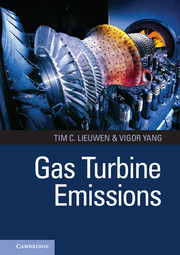Book contents
- Frontmatter
- Contents
- List of Contributors
- Foreword
- Preface
- Part 1 Overview and Key Issues
- Part 2 Fundamentals and Modeling: Production and Control
- 5 Particulate Formation
- 6 Gaseous Aerosol Precursors
- 7 NOx and CO Formation and Control
- 8 Emissions from Oxyfueled or High-Exhaust Gas Recirculation Turbines
- Part 3 Case Studies and Specific Technologies: Pollutant Trends and Key Drivers
- Index
- References
6 - Gaseous Aerosol Precursors
from Part 2 - Fundamentals and Modeling: Production and Control
Published online by Cambridge University Press: 05 June 2013
- Frontmatter
- Contents
- List of Contributors
- Foreword
- Preface
- Part 1 Overview and Key Issues
- Part 2 Fundamentals and Modeling: Production and Control
- 5 Particulate Formation
- 6 Gaseous Aerosol Precursors
- 7 NOx and CO Formation and Control
- 8 Emissions from Oxyfueled or High-Exhaust Gas Recirculation Turbines
- Part 3 Case Studies and Specific Technologies: Pollutant Trends and Key Drivers
- Index
- References
Summary
Introduction
Concerns about particle emissions from aircraft were first raised in the 1960s because of the visible smoke trails left behind by jet aircraft on takeoff. These concerns led to an emission certification requirement for aircraft engines in the 1970s that mandated a smoke number (SN) measurement, which served to control the visible opacity of the emitted exhaust. Understanding of the effects of particle emissions has progressed dramatically since the 1970s, and more knowledge now exists both about carbonaceous soot particles that contributed strongly to the black smoke trails of the 1960s and about how other emissions can condense and add to particle numbers and mass. These latter contributions arise because of gaseous emissions that are products of combustion and also have low-vapor pressures. Having low-vapor pressures, they are thermodynamically disposed to condense as the exhaust mixes and cools in the atmosphere. These condensable species are gaseous aerosol precursors and their contributions to particulate matter pollution are the subject of significant scientific research and regulatory interest.
Like all consumers of hydrocarbon fuels, gas turbine engines emit products of combustion dominated by carbon dioxide and water vapor. In addition to these major products of combustion, the exhaust emissions also include products of incomplete combustion, due to small combustion inefficiencies (very small for modern aircraft engines at cruise), and pollutants formed in the combustion process, like NOx and SOx. Beyond combustion-related emissions, recent work has identified emissions from the lubrication system that also contribute to particle emissions in the exhaust. These various emissions include gaseous species and particles.
- Type
- Chapter
- Information
- Gas Turbine Emissions , pp. 154 - 174Publisher: Cambridge University PressPrint publication year: 2013



